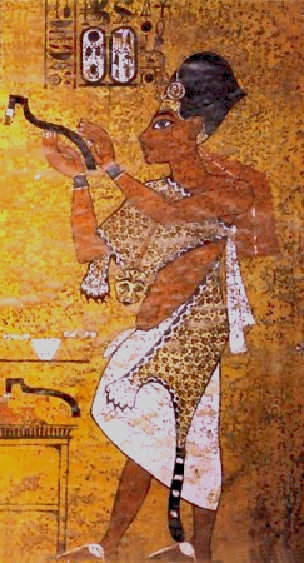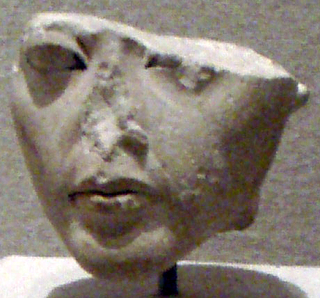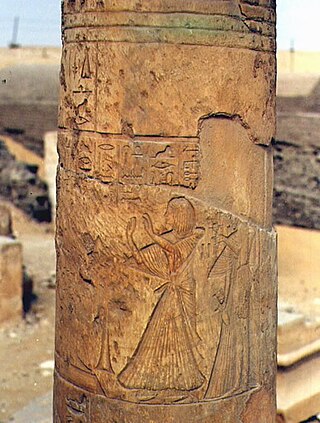
Tutankhamun, Tutankhamon or Tutankhamen, also known as Tutankhaten, was the antepenultimate pharaoh of the Eighteenth Dynasty of ancient Egypt. His death marked the cessation of the dynasty's royal line.

Memphis, or Men-nefer, was the ancient capital of Inebu-hedj, the first nome of Lower Egypt that was known as mḥw ("North"). Its ruins are located in the vicinity of the present-day village of Mit Rahina, in markaz (county) Badrashin, Giza, Egypt. This modern name is probably derived from the late Ancient Egyptian name for Memphis mjt-rhnt meaning "Road of the Ram-Headed Sphinxes".

Kiya was one of the wives of the Egyptian Pharaoh Akhenaten. Little is known about her, and her actions and roles are poorly documented in the historical record, in contrast to those of Akhenaten's ‘Great royal wife’, Nefertiti. Her unusual name suggests that she may originally have been a Mitanni princess. Surviving evidence demonstrates that Kiya was an important figure at Akhenaten's court during the middle years of his reign, when she had a daughter with him. She disappears from history a few years before her royal husband's death. In previous years, she was thought to be mother of Tutankhamun, but recent DNA evidence suggests this is unlikely.
Thutmose, also known as "The King's Favourite and Master of Works, the Sculptor Thutmose", was an Ancient Egyptian sculptor in the Amarna style. He flourished around 1350 BC, and is thought to have been the official court sculptor of the Egyptian pharaoh Akhenaten in the latter part of his reign. A German archaeological expedition digging in Akhenaten's deserted city of Akhetaten, known today as Amarna, found a ruined house and studio complex in early December 1912; the building was identified as that of Thutmose based on an ivory horse blinker found in a rubbish pit in the courtyard inscribed with his name and job title. Since it gave his occupation as "sculptor" and the building was clearly a sculpture workshop, the determination seemed logical and has proven to be accurate.

Horemheb, also spelled Horemhab or Haremhab, was the last pharaoh of the 18th Dynasty of Egypt. He ruled for at least 14 years between 1319 BC and 1292 BC. He had no relation to the preceding royal family other than by marriage to Mutnedjmet, who is thought to have been the daughter of his predecessor, Ay; he is believed to have been of common birth.

Ay was the penultimate pharaoh of ancient Egypt's 18th Dynasty. He held the throne of Egypt for a brief four-year period in the late 14th century BC. Prior to his rule, he was a close advisor to two, and perhaps three, other pharaohs of the dynasty. It is speculated that he was the power behind the throne during child ruler Tutankhamun's reign. His prenomenKheperkheperure means "Everlasting are the Manifestations of Ra", while his nomenAy it-netjer reads as "Ay, Father of the God". Records and monuments that can be clearly attributed to Ay are rare, both because his reign was short and because his successor, Horemheb, instigated a campaign of damnatio memoriae against him and the other pharaohs associated with the unpopular Amarna Period.

Ankhesenamun was a queen who lived during the 18th Dynasty of Egypt. Born Ankhesenpaaten, she was the third of six known daughters of the Egyptian Pharaoh Akhenaten and his Great Royal Wife Nefertiti. She became the Great Royal Wife of Tutankhamun. The change in her name reflects the changes in ancient Egyptian religion during her lifetime after her father's death. Her youth is well documented in the ancient reliefs and paintings of the reign of her parents.
The Amarna Period was an era of Egyptian history during the later half of the Eighteenth Dynasty when the royal residence of the pharaoh and his queen was shifted to Akhetaten in what is now Amarna. It was marked by the reign of Amenhotep IV, who changed his name to Akhenaten in order to reflect the dramatic change of Egypt's polytheistic religion into one where the sun disc Aten was worshipped over all other gods. The Egyptian pantheon was restored under Akhenaten's successor, Tutankhamun.

Maya was an important figure during the reign of Pharaohs Tutankhamun, Ay and Horemheb of the Eighteenth Dynasty of Ancient Egypt. Maya's titles include: fan bearer on the King's right hand, overseer of the treasury, chief of the works in the necropolis, and leader of the festival of Amun in Karnak.

Mutnedjmet, also spelled Mutnodjmet, Mutnedjemet, etc., was an ancient Egyptian queen, the Great Royal Wife of Horemheb, the last ruler of the 18th Dynasty. The name, Mutnedjmet, translates as: "The sweet Mut" or "Mut is sweet." She was the second wife of Horemheb after Amenia who died before Horemheb became pharaoh.
Geoffrey Almeric Thorndike Martin was a British egyptologist, Edwards Professor of Egyptian Archaeology and Philology Emeritus, University College, London, Joint Field Director of the Amarna Royal Tombs Project and fellow commoner of Christ's College, Cambridge.

The Department of Ancient Egypt is a department forming an historic part of the British Museum, with Its more than 100,000 pieces making it the largest and most comprehensive collection of Egyptian antiquities outside the Egyptian Museum in Cairo.

The Memphite Tomb of Horemheb is located in the Saqqara necropolis, near Memphis, Egypt. It was constructed before Horemheb ascended to the throne and was never used for his burial, since he later built the Theban tomb KV57 for this purpose. His two wives Mutnedjmet and Amenia were buried within the structure.

Isetnofret was a royal woman of Ancient Egypt and, as the Great Royal Wife of Pharaoh Merenptah, she became Isetnofret II.

The Eighteenth Dynasty of Egypt is classified as the first dynasty of the New Kingdom of Egypt, the era in which ancient Egypt achieved the peak of its power. The Eighteenth Dynasty spanned the period from 1550/1549 to 1292 BC. This dynasty is also known as the Thutmosid Dynasty for the four pharaohs named Thutmose.

Maarten J. Raven is a Dutch Egyptologist.

The Statue of Horemheb and Amenia is a large double statue of the Pharaoh Horemheb and his wife Amenia that was found at the ancient site of Saqqara in Egypt. Now kept at the British Museum, for many years the identity of the two sitters was unknown until a team of Dutch and British archaeologists discovered a missing fragment of the statue in Horemheb's tomb in Saqqara.

Tia was an ancient Egyptian high official under king Ramses II. His main title was that of an overseer of the treasuries. Tia was married to a woman with the same name, the princess Tia who was sister of Ramses II.
Mose was an ancient Egyptian official with the title scribe of the treasury of Ptah. He lived under Ramesses II, around 1250 BC. He is mainly known from his decorated tomb chapel that was excavated by Victor Loret at Saqqara, close to the Pyramid of Teti. Most of the blocks from the tomb chapel were brought to the Egyptian Museum at Cairo. Mose became after the discovery of the tomb quickly famous within research, as on the walls of his tomb chapel there was long texts reporting a legal battle over a land dispute. The battle went over several generations and is an important document for the history of law in Ancient Egypt. It is most interesting to see how women acted independently at the court.
Jacobus Van Dijk is a Dutch Egyptologist, epigrapher, and philologist of the ancient Egyptian language, who was an Associate Professor of Egyptology at the University of Groningen, The Netherlands. When the university of Groningen decided to discontinue the subject, Professor Van Dijik took early retirement and is now a Professor Emeritus of Egyptology from this University in the Netherlands. Following a brief period at Leiden University, he now works as an independent scholar. Van Dijk studied Egyptology in Groningen with Prof. Herman te Velde, with subsidiary courses in Semitic Languages and History of Religions, and also followed courses in Ptolemaic and Demotic at Leiden University. He graduated with a BA degree in 1975, followed by an MA with a thesis on The Canaanite god Hauron and his cult in Egypt (1978). In 1993, he gained his PhD with The New Kingdom Necropolis of Memphis: Historical and Iconographical Studies. His research mainly focuses on the history and culture of the late 18th and early 19th Dynasties, but he also wrote on the temple of the goddess Mut and on human sacrifice in Ancient Egypt.















